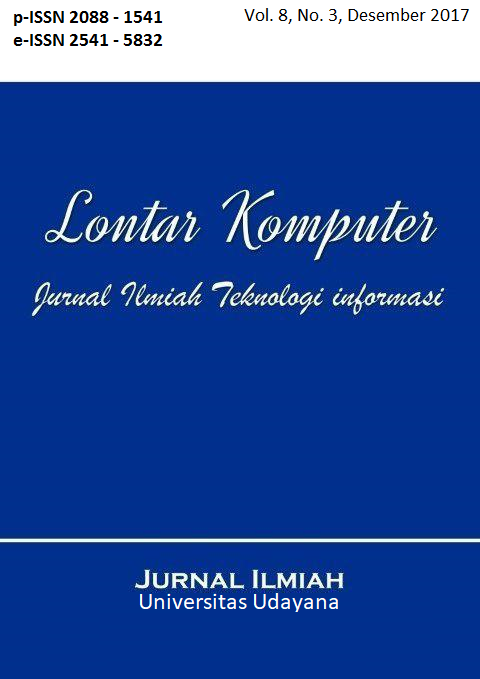Identifikasi Komentar Spam Pada Instagram
Abstrak
Spam pada Instagram (IG) umumnya berupa komentar yang dianggap mengganggu karena tidak berhubungan dengan foto atau video yang dikomentari. Spam pada komentar dapat menyebabkan beberapa dampak negatif seperti menyulitkan untuk mengikuti diskusi pada komentar yang dipenuhi oleh komentar spam dan menyebabkan seseorang tampak populer karena jumlah komentarnya banyak walaupun pada kenyataannya lebih banyak komentar yang berupa spam. Penelitian ini mencoba untuk membangun model yang dapat melakukan identifikasi komentar spam pada IG. Komentar pada IG berbentuk teks, sehingga pada penelitian ini digunakan metode-metode pengolahan teks. Untuk identifikasi digunakan metode Support Vector Machine (SVM). Data komentar yang digunakan pada penelitian ini dikumpulkan dari komentar-komentar pada foto atau video yang dibagikan oleh aktor dan artis Indonesia yang memiliki pengikut (follower) paling banyak di IG. Dari hasil penelitian didapatkan model identifikasi komentar spam dengan metode SVM menghasilkan tingkat akurasi 78,49% yang lebih baik jika dibandingkan dengan model pembanding yang menggunakan metode NB (77,25%). Penelitian ini juga menguji beberapa proporsi data pelatihan yang berbeda-beda dan hasilnya metode SVM tetap lebih baik dibandingkan dengan metode NB. Hasil lain dari penelitian ini adalah tahap pre-processing dan stemming yang harus disesuaikan terutama untuk dukungan terhadap pengolahan karakter-karakter unicode dan simbol-simbol khusus yang banyak ditemukan pada komentar-komentar di IG.
##plugins.generic.usageStats.downloads##
Referensi
2016. [Online]. Available: http://www.musdeoranje.net/2016/08/akun-instagram-dengan-followers-
terbanyak-di-indonesia.html. [Acessed on 9 August 2017].
[2] A. Rachmat and Y. Lukito, “Deteksi Komentar Spam Bahasa Indonesia Pada Instagram Menggunakan Naive
Bayes,” Ultimatics - Jurnal Informatika, vol. 9, no. 1, pp. 50-58, 1 June 2017.
[3] Y. Ko, “How to use negative class information for Naive Bayes classification,” Information Processing &
Management, vol. 53, no. 6, pp. 1255-1268, 2017.
[4] F. G. Wei Zhang, “An Improvement to Naive Bayes for Text Classification,” Procedia Engineering, vol. 15, no.
15, pp. 2160-2164, 2011.
[5] A. Rachmat C e Y. Lukito, “Klasifikasi Sentimen Komentar Politik dari Facebook,” JUISI, vol. 02, no. 02, 2016.
[6] N. O. F. Elssied, O. Ibrahim and A. H. Osman, “Enhancement of spam detection mechanism based on hybrid
kk,” Soft Computing, vol. 19, no. 11, p. 3237–3248, 2015.
[7] L. H. Lee, R. Rajkumar and D. Isa, “Automatic folder allocation system using Bayesian-support vector,”
Applied Intelligence, vol. 36, no. 2, pp. 295-307, March 2012.
[8] S. M. Weiss, N. Indurkhya and T. Zhang, Fundamentals of Predictive Text Mining, 1st ed., London: Springer,
2010, pp. XIV, 226.
[9] G. Forman, “An extensive empirical study of feature selection metrics for text classification,” Journal of
machine learning research, vol. 3, no. March, pp. 1289-1305, 2003.
[10] W. Zhang, T. Yoshida and X. Tang, “A comparative study of TF-IDF, LSI, and multi-words for text
classification,” Expert Systems with Application, vol. 38, no. 2011, pp. 2758-2765, 2010.
[11] R. Hail, “Towards a Fusion of Formal and Informal Learning Environments: The Impact of the Read/Write
Web,” Electronic Journal of e-Learning, vol. 7, no. 1, pp. 29-40, 2009.
[12] J. A. Lara, D. Lizcano, M. A. Martínez and J. Pazos, “Developing front-end Web 2.0 technologies to access
services, content and things in the future Internet,” Future Generation Computer Systems, vol. 29, no. 5,
pp. 1184-1195, 2013.
[13] Y. Lukito and A. R. Chrismanto, “Perbandingan Metode-Metode Klasifikasi untuk Indoor Positioning
System,” Jutisi (Jurnal Teknik Informatika dan Sistem Informasi), vol. 1, no. 2, pp. 123-131, 2015.
[14] D. Ariadi and K. Fithriasari, “Klasifikasi Berita Indonesia Menggunakan Metode Naive Bayesian
Classification dan Support Vector Machine dengan Confix Stripping Stemmer,” JURNAL SAINS DAN SENI
ITS, vol. 4, no. 2, pp. D248-D253, 2015.
[15] S. N. D. Pratiwi and B. S. S. Ulama, “Klasifikasi Email Spam dengan Menggunakan Metode Support Vector
Machine dan k-Nearest Neighbor,” JURNAL SAINS DAN SENI ITS, vol. 5, no. 2, pp. D-344 - D-349, 2016.
[16] H. Jiawei, K. Micheline and P. Jian, Classification: basic concepts. In Data mining Concepts and techniques
(3rd ed.), Amsterdam: Elsevier, 2011.
[17] S. M. Dr. Suyatno, Data Mining untuk Klasifikasi dan Klasterisasi Data, Bandung: Informatika, 2017.
[18] X. Deng, Q. Liu, Y. Deng e S. Mahadevan, “An improved method to construct basic probability assignment
based on the confusion matrix for classification problem,” Information Sciences, vol. 340–341, no. 1 May
2016, pp. 250-261, 2016.
The Authors submitting a manuscript do so on the understanding that if accepted for publication, the copyright of the article shall be assigned to Jurnal Lontar Komputer as the publisher of the journal. Copyright encompasses exclusive rights to reproduce and deliver the article in all forms and media, as well as translations. The reproduction of any part of this journal (printed or online) will be allowed only with written permission from Jurnal Lontar Komputer. The Editorial Board of Jurnal Lontar Komputer makes every effort to ensure that no wrong or misleading data, opinions, or statements be published in the journal.
 This work is licensed under a Creative Commons Attribution 4.0 International License.
This work is licensed under a Creative Commons Attribution 4.0 International License.























